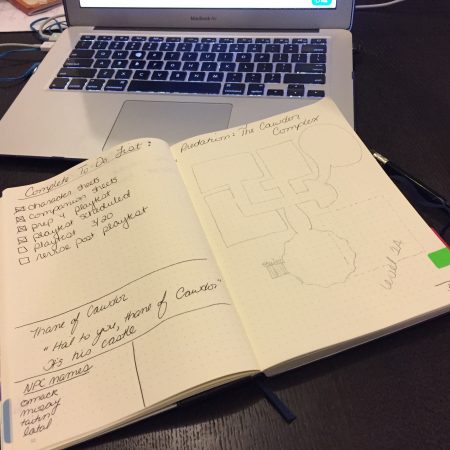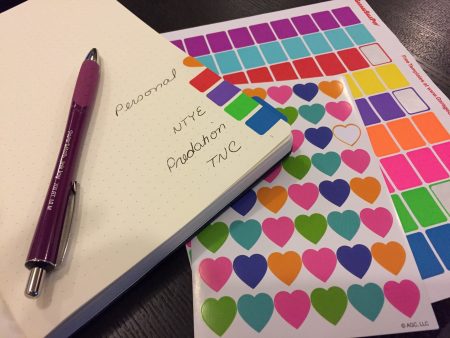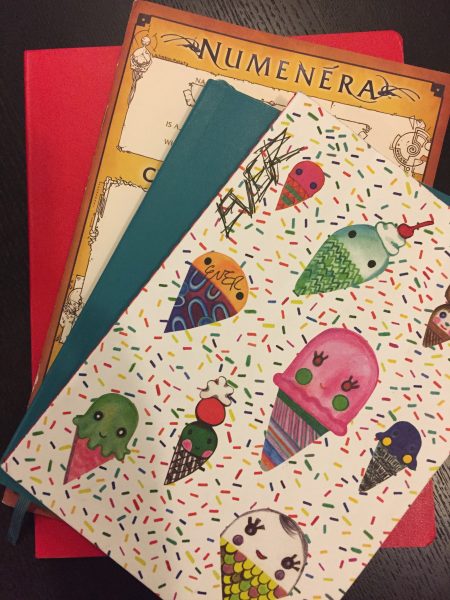If you’re not sure what bullet journaling is, exactly, then I apologize ahead of time for the slightly addicting world I’m about to throw you into. A bullet journal—sometimes called a bujo—is basically a single, organized journal that is customizable enough that you can use it for a number of purposes. To-do list, notebook, diary, sketchbook, memories, and more. Just Google “bullet journal” or do a search for #bujo on Pinterest or Twitter, and you’ll have more information, suggestions, and examples than you can probably use in a lifetime.
Here’s a good place to start: BulletJournal.com
There’s a lot of information out there about bullet journals for artists and writers out in the world (including one that I wrote while working on my last novel), but bullet journals can also be fantastic for the gaming table, whether you’re a GM or a player (or a designer). Here are some basics for getting started:
Choose the Journal that Fits your Gaming Needs
I have a single bullet journal that covers everything in my life, from my daily to-do list to my writing projects to games that I’m GMing. I like to use hardcover, medium-sized books with dotted pages, because they allow more flexibility for writing, drawing, map-making, and whatever else I need to do, but there are tons of options out there. Go small, go big, go squares, lined, or blank (there are even some that are a mix). Hardcovers can be stood up like GM screens, if that’s something that’s useful for you, while softcovers are lighter to carry around. If you sketch a lot, you might enjoy a larger journal with blank pages. Try out a few and see what you like best.
I do use separate thinner bullet journals for each of my long-running characters in our games. I started out keeping character notes in my regular journal, but quickly realized that I liked the idea of having a journal that said something about the character and the game—cute ice cream cones for my teenager in our post-apocalyptic Cypher System game, a Numenera character portfolio (with blank pages added to the middle) for our Into the Outside campaign, a plain teal journal full of secrets for my Invisible Sun character, and so on. You could do the same thing for GMing, if you GM a lot and like to keep things more separate.
Organize it Your Way
The biggest benefit of a bullet journal is that you can keep everything in your life loosely organized in a single place. For GMs, this means that you can have a single journal that covers a bunch of different campaigns, characters, adventures, and more.
One of the draws of a bullet journal is that you don’t have to keep everything in order (this is one of the things that differentiates a bullet journal from a regular journal). You typically have no idea how many pages each campaign is going to take up, so this lets you take notes as you need to for each campaign without worrying about “saving” pages. I can make notes about my Predation campaign on one page, notes about my No Thank You, Evil! campaign on the next, and then have a page of notes about our next Kickstarter, then return to Predation notes, and I can still find everything.
There are a million different ways to organize everything, and you might want to work through a few different systems before you find the one that’s right for you.
Here’s how I do it:
Index: Most bullet journals have an index, where you list the page numbers of whatever you want to find. I mark the page number of each campaign’s main spread (see below) in the index.
Main Spread: Each campaign or adventure that I run gets a main spread. On that page are the things I reference a lot: it could be a to-do list, the characters’ and players’ names, a list of NPC names, a map, pages in the rules book that I’ll want to be able to find quickly, and so on. This is the also the spread where I’ll tuck my loose papers for that campaign, including maps, art, or handouts. This is the page number that I list in the index (above).

More Pages: Future pages include notes about everything else that happens in the game; I typically end up with a two-page spread per session, but sometimes it’s more. Anything that happens that I’ll want to reference later gets a note on the main page, along with the page number on which it appears. So, if I introduce an NPC in session 3 that I know we’ll return to, I’ll make a note on the campaign’s main page with the NPC’s name and the page that their info is on. Don’t be afraid to cut and paste as well–maps, sketches, character or setting art, and even rules reminders can all be pasted right into the journal.
Alternatively, you could organize these additional pages by topic, rather than by session. So, one page for your main city, one page for all of the NPCs the characters have encountered, one page for creatures, and so on. I find this requires more back-and-forth during a session, but it does keep each topic together neatly.
Colored Tabs: For me, the real trick to making this all work is colored tabs. Each campaign gets a color, which is also labeled in the index. Here, you can see that my current Predation campaign has a green label. So, every time I make a new page or spread about that campaign, I fold a green sticker over the edge of that page. It makes it easy to flip through the journal and find all my notes for each campaign, even if they’re spread out.
If you wanted to keep a separate journal for each of your campaigns, you could still use the same organization system. Instead of each campaign getting a colored label, each category in the campaign would get one. So setting items (including art, maps, and descriptions) might all get a green tag, while NPCs and creatures might all get purple. Session notes would be in blue and anything else that you wanted to be able to find easily would get a different color.

Lists: I mark off a small section in the back of my journal for lists. All lists get a note in the index so that I can find them quickly. My lists include things like Books to Read, Games to Play, Movies to Watch, and Gifts to Give. But there’s also a set of GM lists: NPC and setting names to pull from, cyphers that I might want to hand out, GM intrusion ideas, campaign suggestions for the future, and an unofficial tally of how often Bruce Cordell rolls a 1 (it’s quite high).
Extra Goodies and Ideas
Pen and Pencil Holder: I’m forever losing my favorite writing utensils, so I purchased a holder that slides over the journal’s cover and has room for both a pen and a pencil.
Pockets: Some journals have built-in pockets to carry XP cards, images, a small stack of sticky notes, your tabs, and so on. You can also add stick-on pockets in various sizes. Alternatively, you can buy a leather or fabric cover for your journal; these typically have various pockets that are great for holding cards, writing utensils, and notes.
Bookmarks, Tape, and Tabs: I mostly use stickers as my tabs—they’re easy to carry in my journal’s pocket, and they never fall off. Bookmarks are great, as long as they don’t fall out (a journal with a closure of some kind keeps this from happening, and I find that using a GM intrusion or cypher card as a bookmark does double duty). You can also purchase tape with cool designs to mark the edge of the pages or use a highlighter to mark the edges of each page.
Sticky Notes: I typically have a couple of sticky notes for each campaign. One lists the characters’ and players’ names. Some are reminders like, “Don’t forget to hand out GM intrusions!” or “Remember that they’re traveling with Jexon the NPC.” It might also be something important that I want to remember from the previous session or even something personal, like if it’s a player’s birthday. I like putting this stuff on sticky notes, because I can move each note to the spread for the current session, and then move it back to the main page or get rid of it, once it’s no longer needed.
Additional Resources:
WTF is a Bullet Journal and Why Should You Start One?
Bullet Journal for GMs G+ Group
